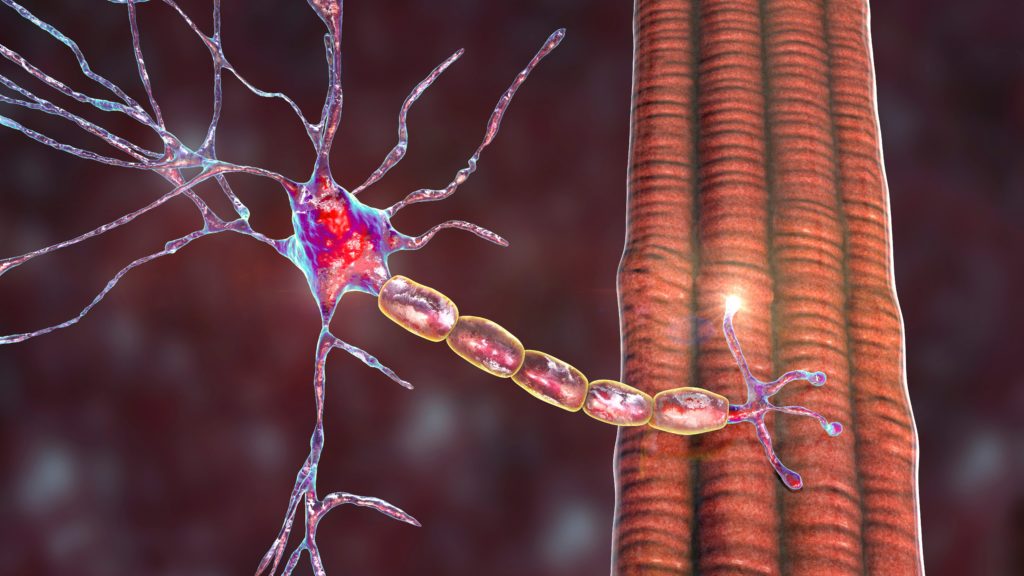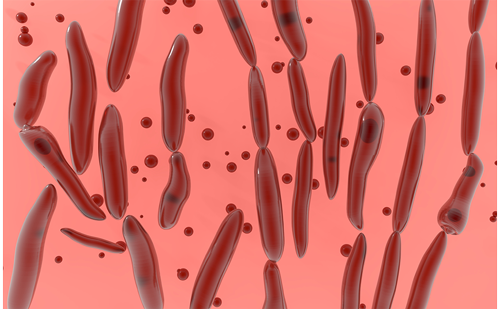Amyotrophic lateral sclerosis (ALS), also called Lou Gehrig’s disease, is a late-onset progressive motor neuron disease first identified in 1869 by Jean-Martin Charcot. Its incidence is approximately two cases per 100,000, with a slightly higher prevalence in men. The progressive degeneration of motor neurons in ALS leads to neuron death and loss of muscle function. Patients become partially or totally paralyzed, but their cognitive functions usually remain unaffected. There is no cure for ALS and the disease is usually fatal within three to five years of the onset of symptoms. About 90% of ALS cases are sporadic, while approximately 10% are inherited in a dominant manner. Mutations in the gene coding for superoxide dismutase 1 (SOD1) account for 20% of all familial cases. To date, more than 140 mutations have been found in the SOD1 gene, and transgenic mice overexpressing various SOD1 mutants develop an ALS-like phenotype through a gain of unknown toxic properties.
Intermediate Filament Alterations in Amyotrophic Lateral Sclerosis
The neuronal cytoskeleton is composed of three interconnected structures: actin microfilaments, microtubules, and intermediate filaments (IFs). Neurofilaments (NFs) are the major IFs present in adult neurons and their expression is restricted to neuronal cell types. Neurons express differentially several IF proteins depending on their stage of development or their localization in the nervous system: nestin (200kDa), NF triplet proteins (NFL [light, 68kDa], NFM [medium, 160kDa], and NFH [heavy, 205kDa]), α-internexin (66kDa), peripherin (57kDa), and synemin (41kDa).1
One of the pathological features of both sporadic and familial ALS is the presence in motor neurons of axonal spheroids and perikaryal accumulations comprising NFs and/or peripherin.2 NFs in perikaryal aggregates are extensively phosphorylated, while this occurs normally only within the axon.3 A 70% decrease in levels of NFL messenger RNA (mRNA) in degenerating neurons of ALS was reported concomitantly with a decrease of α-internexin or peripherin mRNA levels.4 It is also interesting to note the presence of high NFL levels and auto-antibodies against NFL in the cerebrospinal fluid of ALS patients.5,6
Codon deletions or insertions in the lysine–serine–proline (KSP) repeat motifs of NFH have been identified in a small number of patients with sporadic ALS,7–9 and are being viewed as a risk factor for the disease. However, two other studies failed to identify variants in the NF genes linked to sporadic and familial ALS,10,11 suggesting that mutations in the NF genes are not a systematic common cause of ALS. By contrast, several mutations in the NEFL gene have been linked to Charcot–Marie– Tooth disease.12–15 A frameshift deletion in the peripherin gene has also been discovered in a sporadic ALS case.16
Neuronal IF abnormalities in ALS may also occur as a result of post-translational protein modifications. Indeed, advanced glycation end-products were detected in NF aggregates of motor neurons in familial and sporadic ALS.17 Moreover, Crow et al.18 showed that SOD1 can catalyze nitration of tyrosines by peroxynitrite in the rod and head domains of NFL. However, no significant changes were detected in the nitration of NFL isolated from cervical spinal cord tissue of sporadic ALS cases.19
Possible Mechanisms Leading to the Formation of Intermediate Filament Aggregates in Amyotrophic Lateral Sclerosis
Several factors can potentially induce the accumulation of NFs in neurodegenerative diseases, including dysregulation of NF gene expression, NF mutations, defective axonal transport, abnormal post-translational modifications, and proteolysis. Toxic agents are also responsible for NF aggregations (see Table 1).
In the case of ALS, the mechanisms governing the formation of IF aggregates are still not clearly established. There is evidence that IF accumulations could result from defects of axonal transport or from abnormal stoichiometry of IF proteins. Perturbations of NF axonal transport is one of the earliest pathological changes seen in several transgenic mouse models of ALS.20–22
Phosphorylation changes might be involved. Abnormal phosphorylation of NFs can affect their axonal transport and lead to their accumulation in cell bodies and in proximal axons. Many studies support the view that the rate of NF transport is inversely correlated to their phosphorylation state (for a review see reference 1). The premature phosphorylation of NF tail domains in motor neuron cell bodies could directly mediate their accumulation in this region. Glutamate excitotoxicity, another pathogenic process in ALS, may induce abnormal phosphorylation of NFs. Treatment of primary neurons with glutamate activates members of the mitogen-activated protein kinase (MAPK) family that phosphorylate NFs with ensuing slowing of their axonal transport.23 In addition, glutamate leads to caspase cleavage and activation of protein kinase N1 (PKN1), an NF head-rod domain kinase.24 This cleaved form of PKN1 disrupts NF organisation and axonal transport.
Finally, excitotoxicity mediated by non-N-methyl-D-aspartic acid (NMDA) receptors is also associated with the aberrant co-localization of phosphorylated and dephosphorylated NF proteins.25 Inhibition of Pin1 was suggested as a possible therapeutic target to reduce pathological accumulation of phosphorylated NFs.26 Pin1 is a prolyl isomerase that selectively binds to phosphorylated proline-directed serine/threonine residues in target proteins and isomerizes cis isomers to more stable trans configurations. Pin1 associates with phosphorylated NFH in neurons and is co-localized in aggregates found in the spinal cord of patients with ALS.26 The inhibition of Pin1 reduces glutamate-induced perikaryal accumulation of phosphorylated NFH.
Alterations of the anterograde or retrograde molecular motors may also be responsible for the aggregation of IFs. Mutation of dynein or p150glued,27 overexpression of dynamitin (the sub-unit of the dynein–dynactin complex that dissociates cargo from dynein),28 and absence of kinesin heavy chain isoform 5A (KIF5A)29 induce NF accumulation in mice. Recent studies suggest that inhibition of retrograde transport is more prone to causing accumulation of NFs than is inhibition of anterograde transport. The inhibition of dynein by increasing the level of dynamitin induces aberrant focal accumulation of NFs within axonal neurites, whereas inhibition of kinesin inhibits anterograde transport but does not induce similar focal aggregations.30 Similarly, the neuron-specific expression of bicaudal D2 N-terminus (BICD2-N), a motor-adaptor protein, impairs dynein–dynactin function, causing the appearance of giant NF swellings in the proximal axon.31
Modification in NF stoichiometry was also proposed to induce accumulation of NFs. The overexpression of different NF sub-units in mice provokes the formation of NF aggregates.32–34 Remarkably, the motor neuron disease caused by excess human NFH (hNFH) can be rescued by overexpression of hNFL in a dosage-dependent fashion.35 Overexpression of peripherin provokes late-onset motor neuron degeneration in transgenic mice.36,37 The motor neuron loss is preceded by axonal transport defects and formation of axonal spheroids.38 Interestingly, NFH overexpression abolished the formation of axonal spheroids that might block transport. These findings illustrate the importance of IF protein stoichiometry in the formation, distribution, and toxicity of neuronal IF inclusions.
In ALS, there is a 70% decrease in levels of NFL mRNA observed in degenerating motor neurons.4 This could be due in part to modification in the stability of their mRNA. Ge et al.39 have shown that ALS-linked SOD1 mutant proteins bind to and destabilize NFL mRNA whereas normal SOD1 does not. Moreover, 14-3-3 and trace amine receptor (TAR) DNA-binding protein 43 (TDP-43) are two proteins incorporated in ALS intraneuronal aggregates that bind and destabilize NFL mRNA,40,41 a phenomenon that could contribute to the aggregation of NFs in ALS.
Mouse Models with Neurofilament Abnormalities
In the last two decades, the gene-targeting technique and transgenic mouse approaches have been used to investigate the contribution of cytoskeletal abnormalities in ALS pathogenesis (see Table 2). Evidence that NF disorganization in vivo can provoke neuronal death came from the observation that expression of a mutated NFL protein42 or of an excess of peripherin36 in transgenic mice induced the formation of ALS-like NF aggregates and selective degeneration of spinal motor neurons.
Abnormal NF accumulations have been detected in familial ALS cases due to SOD1 mutations.43 Similarly, transgenic mice expressing mutant SOD1 exhibit NF accumulations44,45 and defective axonal transport of NFs in motor neurons.20,21 To determine whether axonal NFs are involved in SOD1-mediated disease, mice expressing mutant SOD1 were mated with mice having low axonal NF content.46,47 The results indicated that axonal NFs are not required for SOD1-mediated disease. Nonetheless, the absence of NFL in SOD1G85R caused depletion of axonal NFs and extension of lifespan by approximately 15%.46 Surprisingly, overexpression of hNFH in SOD1G37R mice47 and of mouse NFL or mouse NFH in SOD1G93A mice48 also increased their lifespan by 65 and 15%, respectively. However, the mechanism of protection is still unclear. NF proteins contain multiple calcium binding sites.49
Therefore there is a possibility that perikaryal accumulations of NF proteins may act as calcium chelators to confer neuroprotection in a manner reminiscent of the calcium-binding protein calbindin-D28k when overexpressed in cultured motor neurons.50 Nguyen et al.51 also proposed that perikaryal accumulations of NFs in motor neurons may alleviate ALS pathogenesis by acting as a phosphorylation sink for cyclin-dependent kinase 5 (CDK5) dysregulation induced by mutant SOD1, thereby reducing the detrimental hyperphosphorylation of tau and other neuronal substrates. However, this hypothesis has been challenged because removal of NFM and NFH sidearms also led to a delay of disease in SOD1 mutant mice,52 probably through enhancement of anterograde axonal transport.
Alternatively, such apparent discrepancies may reflect the existence of multiple neuroprotection mechanisms. It is noteworthy that hNFH overexpression conferred more robust protective effects than deletion of NF sidearms, with lifespan extension of six months compared with two months in the SOD1G37R mice.39,43 The superior protective effects of hNFH overexpression could have resulted from depletion of axonal NF content together with phosphorylation sink of perikaryal NF accumulations. Finally, Ehlers et al.53 have shown that NFs are involved in localisation of NMDA receptors in the neuronal plasma membrane by interacting with the NMDA NR1 sub-unit, suggesting that accumulation of NFs may interfere with glutamate receptor function. There is a report that NF-aggregate-bearing neurons exhibit increased intracellular calcium levels and enhanced cell death in response to NMDA-mediated excitotoxicity.54
Conclusion
Accumulation of NFs in ALS was described for the first time several decades ago. Nevertheless, how the NF accumulations arise and the extent to which they contribute to disease pathogenesis is not fully elucidated. Lines of evidence suggest that perturbations of axonal transport or of IF protein stoichiometry can contribute to formation of intraneuronal IF inclusions, these two mechanisms not being mutually exclusive. Alterations in the stoichiometry of IF proteins can result from destabilization of IF mRNAs. Aberrant phosphorylation of NFs can also affect their axonal transport, but this phenomenon is poorly understood. A regulation of NF interactions to molecular motors is most probably involved in controlling NF movement. In order to develop a therapeutic approach able to restore a normal axonal transport of NFs in ALS, it will be important to identify which molecular motors and adaptor proteins are involved in this process. In mouse models, some types of NF accumulation correlate with motor neuron degeneration, whereas others seem to confer protection. The toxicity or benefit of NF accumulations could be due to differences in their localization (perikaryal versus axonal) and their ability to block fast axonal transport and sequestrate other vital organelles, such as mitochondria. ■













